As our taxi pulled up to the immense stone causeway that leads into the worlds largest religious structure, the only sounds that we could hear were the yells from children:
"Hello"
"Hola"
"Bonjour"
"Slainche"
"Bonjourno"
"Goedemorgen"
If I had to bet on which countries children are the most adept at learning languages, I would have to put all of my money on Cambodia. The children, by virtue of necessity, can speak about a dozen languages with enough proficiency to get people from nearly any country to buy their postcards. Of course, English being the language of bartering the world over, more often than not I could make out what was going on, an unususal state of affairs for me.
Siem Reap, located 5.5 km South of Angkor Wat, is a city rebuilding itself at a lightning pace. Since Angkor was declared a UNESCO World Heritage Site in 1992, the main conduit of tourism, which is one of the country's biggest industries, has focused on that narrow path leading between town and temple. You wouldn't expect to find a first rate Mexican restaurant in the middle of Cambodia. Neither would you expect to find a European bakery or an enormous, Guiness-pouring Irish pub in the center of town. Since you wouldn't expect these things, like me, you'd be surprised when they were suggested to you by the swarming multitudes of street children.

This little girl was like a walking Fodor's guide for Siem Reap. She knew where to find the best aioli!
There is a thriving, nearly vibrant night life that goes on from about 7pm until bar close, which appears to be right around dawn, just long enough for people to stumble home and catch enough shut-eye to spend the rest of the day perusing some of the greatest architectural achievements on the planet.
Angkor Wat has been described so many times, by so many people that it is nearly useless to add to the lexicon of praise here. Nonetheless, to arrive on the site, and begin the nearly 1km walk that beings by crossing a moat 190 meters wide, which surrounds the entire site, through a massive archway, and finally into the temple grounds themselves is nothing short of super-awesome (I defy you to find any piece of literature, anywhere that refers to Angkor Wat as such. I'm breaking new ground here people).

The view...about to enter all that is superawesome!
From there, it is a mere jaunt of another half a kilometer until you are within the temple itself. The grounds leading up to the temple are dotted with ancient shrines and two immense libraries, each individually worthy of a day or so of exploration. However the siren song of five soaring, spired and shingled towers looms over you and implores you onward.

Getting closer...

....annnnd very slightly closer
Finally, you are under the main gate
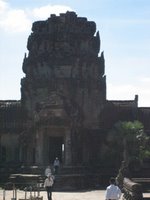 ...
...Nearly there...
...and as you pass through, you are witness to one of the most awesome, powerful, and lasting images that I have ever encountered. A simple camera could never capture the depth of the moment, as you enter a murky hallway, and see the towers rising above you through a narrow door.

Are you getting a sense of how long this took?

okay this is getting absurd...
Careful, you're about to learn something:
The temples of Angkor comprise over a thousand structures, ranging from the nearly perfect Angkor Wat, to barely a pile of stones, hardly identifiable as having once been anything. There are perhaps 20-30 temples that are still easy enough to identify to justify a visit as a tourist. The temples were built by the Khmers between the 9th and 15th centuries, and are considered to be the supreme architectural works of that culture. The big poppa of all the temples, Angkor Wat, was built by and for King Suryavarman II between 1112 and 1150. The layout is unique with respect to Buddhist and Hindu monuments, as it is oriented West, whereas most temples are oriented East. Scholars are still debating this oddity, however one of the theories posits that as this temple was dedicated to Vishnou, as opposed to Shiva, the Westward orientation makes sense as Vishnou's normal association is with the West. This is supported by the art of the bas-relief that scrolls all the way around the inside of the temple. This exquisite work of art (believed to be the longest work of carved art on Earth) is meant to be read while being kept on one's left, the opposite of the tradition at most other Angkorian monuments.

We're there! Here! Whatever!
The temple itself is modeled after Mount Meru, home of the Gods in Hindu mythology. It is a common misconception that Angkor Wat has only three towers, as when viewed head-on, that is all you can see, however, the temple structure is actually called a quincunx, which means an arrangement of five objects with four at the corners and one at the center, and which sounds like a method of leaping backward and forwards through time, or possibly a smelly Anthony Quinn. Either way, entering the grounds brings with it a sense of both timelessness and contrast. As you wander the grounds it is impossible not to hear the voices in the back of your mind, those of the Khmer Rouge, and their victims, trying to tear away all the civilization and beauty that was created by these people. Fortunately, the Khmer Rouge largely left the temples of Angkor alone, and due to the massive walls surrounding Angkor Wat, it has largely been preserved from the ravages of a jungle that has been all to eager to swallow its lesser neighbors.

Inside the walls. If you're wondering, the color of that sky is perfect. It's on the color spectrum between Indigo and Mauve

It took myself, Aidan and Lorraine (my friends of long standing at this point, there through thick and thin and kind of gross since way back in Laos) nearly an hour to simply find each other after splitting up at the site.
Have I mentioned the steps yet?

That boy on the steps is actually 3oo0 feet away. Neat optical illusion huh?
No description of Angkor Wat would be complete without a mention of one of the less illuminating aspects of a visit. In short: There are many, many steps to be climbed. These steps are very, extremely, umm...really steep. Like, scaling a vertical wall steep. After much huffing and puffing, one finds oneself at the uppermost level of the temple, and is greeted with scenes such as these:

"...oh soooola mia....."



"Hi, I'm the Buddha with the head. Aren't I nice?"

"........" (translation: Hi, I'm the Buddha without the head. Sucks huh?)
If you'll note the last two images, you'll see something about the Buddhas represented therein. One has a head, one does not. Three guesses as to which was the more common sight...

There is nothing funny about this picture. Beheaded deities are no laughing matter..which is why I got kicked out...
Well, since you are so clever, oh wise and gentle reader, you of course surmised that there are far more headless Buddhas than those who remain un-discombobulated. The simple reason for this is that every time that any group has ever decided to try and overtake Cambodia, it was decided that the best way to begin would be by beheading their most relevant deities. Makes sense if you think about it. Irony of ironies, the Khmer Rouge largely left the temple sites alone.
The arching, vaulted ceilings, vast sunken rooms, and multitudinous prayer areas and shrines could be explored for days in Angkor Wat, but our 50 dollar passes (and for the record, I cannot as of the time of this writing recall anything else on my entire trip that cost that much. Not even flights that I bought while in South Africa and India. This should actually be an entire other post, but here is unfortunately relegated to a parenthetical. As it turns out, only 28% of the revenue that comes into the Angkor temples goes towards their upkeep and refurbishing. The rest goes to a shady cabal of international companies who turn a massive profit on the whole endeavor. The filmy sheen that I had to scrub off of myself every night after temple-hopping wasn't sweat, it was corporate malevolence...and I can assure you, it clings), were only good for 3 days, and with so much to see, it was time to be on our way.

Temple, from a distance...duh.
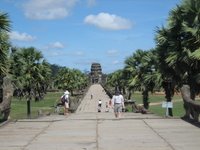
Reverse view. The long walk home
The next stop on the normal first day temple tour is the site known as Bayon. Whether or not you are a professor of Khmer Studies at at a leading institution (which, perhaps you are), Bayon is fairly recognizable due to its unique architecture, spiritual importance and oh yeah...
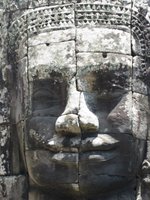
"Arghhh!! I'm a huge stone head!"
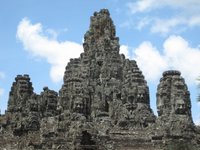
(Chorus): Argh!! We're 200 huge stone heads!
...hundreds of enormous stone heads! One of the main reasons for visiting the temple is to see the painstakingly, meticulously rebuilt library that took dozens, perhaps hundreds of graduate students and archaeleogists years and years to finish. I, of course, didn't get a single picture of it. I was too busy with looking at things like:
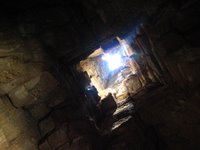
If you hold the scepter of light at exactly the right time, at just the right angle...you get the location of the recipe of the perfect bowl of noodles....mmmm mysteriously delicious
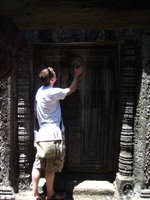
Aidan thought he had discovered a doorway to Nirvana. Turns out it was a doorway to a record store that specialized in used Nirvana tapes. He got In Utero for 2 bucks!

It's a spiderweb, it looked nice in the light. What? Every picture has to be something you've never seen before?
As you peruse the exterior, it has hard not to feel like you are being watched. And this feeling becomes more prevalent, the more you look around. Fortunately, you are in good company with this uneasy feeling, as nearly everyone feels somewhat offput by the nearly 200 enormous carved stone faces that surround you everywhere you go. Bayon is unique for a few reasons in Angkor architecture: It is one of the only temples not surrounded by an outer wall, the prominence of the library indicates that it was significant both as a religious, and as an educational site, and it was constructed roughly 100 years after Angkor Wat, however there is evidence that points to it having been completed over a very long period of time, perhaps even longer than it took to complete Angkor Wat.

Wide angle view...big place
But really, you only want to know about the faces. (Sigh)...my poor, short attention-spanned readers.
Well, there is some dispute over exactly who or what the faces are depicting, but there is a general scholarly consensus (isn't it nice when nerds get along?) that the faces are either Jayavarman VII or Avalokitesvara. Although neither of those names probably mean much to you, the latter is extremely important in Buddhism. Without getting to in-depth here, the Avalokitesvara is the embodiment of all of the compassion of all of the Buddhas. As such, he is the most highly revered Bodhisattva (and to carry out the explanation one degree further the bodhisattva is the " being who is dedicated to assisting all sentient beings in achieving complete Buddhahood)(for further reading that won't help a whit in understanding what an Avalokitesvara or Bodisattva is, but will give you a look into the mind of a brilliant writer to whom those terms meant a lot, check out "The Dharma Bums" by Jack Kerouac).
Anywho, we spent quite a bit of time wandering around, taking goofy pictures with the heads. That was my trip to Bayon. I am quite the student of culture huh?

"...just the two of us..."

"...just the two of us..."
Joking aside (though never entirely aside) Bayon is a place where you begin to wonder at any ghost story, mystical happening or alien landing that you've ever heard about. At a place like this, anything seems possible. There are some places in the world that seem to hold magic and mystery, beyond rational comprehension, places that leave you with a sense of wonder. Bayon, as fully as anyplace else that I have been, evokes these feelings. There is a hushed, overpowering atmosphere (when not congested with tour groups) that seems to demand silence and obeisance to...something.
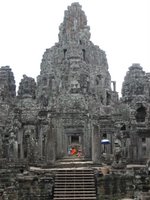
It is interesting to note the different characteristics of the many faces at Bayon. Each face is slightly different from its mates, a fact that is pointed out in any number of tour guides and plaques at the site. Some of the faces are clearly happy, some seem angry, others demure or amused and still others paternal and knowing. It would be easy to spend a whole day, just trying to catalogue the look on each face, and interestingly enough, there are as many different interpretations, even for the same face, as there are people to look at it. While standing and staring at a face that to me looked joyful, a young boy passed me and gave a shudder. I asked him what was wrong (helpful scruffy stranger that I am) and he said that it looked like the face was mad at him.


What do you see in the faces?
As we left the temple, walking away down a wide stone path with our backs turned on the faces, I couldn't help but again get the feeling that for good or evil, we were being watched over as we made our way onwards. To me, it was comforting, but it seems to weigh differently on each person who visits.

Casting call picture for the sequel to the Danny Devito/Arnold Schwarzenegger film "Twins" entitled "Unlikely Twins at Buddhist Temples"
After sweating profusely at Bayon, it was a 2km walk to another temple whose name I forget, largely because it was under renovation and I didn't get anywhere near it. Fortuantely, this brought us right to the part of the day that I was looking forward to the most...a visit to the Terrace of the Leper King.
What is the historical significance, factual background and scholarly opinion on the Terrace...well, I'll tell you...
Psych.
You don't want to hear that. Neither did I. I just wanted to do this:



"Hey...hey look at me...I'm the LEPER KING. I've got LEPROSY...ew...I'm all leprous because I'm the KING OF THE LEPERS...WAHHHHHH"
We finished the day by gazing vacantly at the Terrace of the Elephants, about which I know nothing, but made for a nice picture which you may enjoy...now.

Terrace of the Elephants. Neat.
Next: A trip way...way out, and some Indiana Jones style adventure...not to be missed!
















